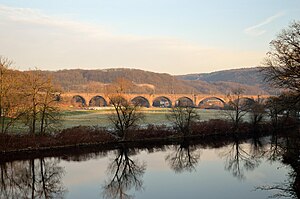Ruhr Viaduct (Witten)
Coordinates: 51 ° 25 ′ 34 ″ N , 7 ° 20 ′ 42 ″ E
| Ruhr Viaduct in Witten | ||
|---|---|---|
| View from the west of the concrete arches of the viaduct | ||
| use | Witten – Schwelm railway line | |
| Crossing of |
Ruhr , Ruhr Valley Railway , |
|
| place | Witten | |
| construction | Steel and concrete arch bridge | |
| overall length | 716 m | |
| width | 8.2 m | |
| Number of openings | 17 concrete arches clad with sandstone 3 steel arches |
|
| building-costs | 22.7 million marks | |
| start of building | 1913 | |
| completion | 1916 | |
| opening | October 4, 1926 | |
| location | ||
|
|
||
The Ruhr viaduct in Witten spans than railway - bridge the Ruhr in North Rhine-Westphalia , Germany .
The route of industrial culture describes the building as a “ viaduct like a picture book” . The stone-clad concrete - arch bridge spanning over a length of 716 meters with the 20 sheets Ruhrtal. The route runs over the viaduct in an arc with a minimum radius of 500 meters. With a width of 8.2 meters, the structure covers an area of 5,877 square meters. Construction of the viaduct began in 1913 at the same time as the construction of the railway line from Witten to Schwelm and was completed in 1916. The construction of the further route was delayed by the First World War and the subsequent occupation of the Ruhr . On October 4, 1926, the section Witten Hauptbahnhof - Wengern Ost was opened. At first the viaduct was only used for freight traffic ; from 1934 passenger trains crossed it on the finally completed railway line Witten – Schwelm , for which it was originally built. The height of the structure above the Ruhr was determined by this no longer existing route, as a significantly lower bridge would have been sufficient for a simple connection of the Witten main train station to the Ruhr Valley Railway on the opposite bank of the Ruhr . The Ruhr Valley Railway was connected to Wengern via a line that was built later . The construction costs amounted to around 22.7 million marks (around 55 million euros in today's purchasing power ).
During the planning phase, the bridge met with broad resistance from the population, who rejected it as a disfigurement of the landscape. The protest could not prevent the bridge, but managed to have the structure clad with natural stone. The threatened demolition shortly before the end of the Second World War was prevented by the intervention of some railway workers. Today the viaduct is only used by freight trains between Witten and Hagen - the railway line to Schwelm has been closed since 1983, regular passenger traffic between Witten and Hagen-Vorhalle has been suspended since 1986. Occasionally, however, passenger trains also run over the viaduct when the railway line between Witten and Hagen (part of the main line of the former Bergisch-Märkische Eisenbahn-Gesellschaft ) is closed due to construction work.
The Ruhr Viaduct ends on the north side of Witten with three steel arches , for which various purely speculative explanations are in circulation. According to more recent findings, the construction of the steel arches is said to have been carried out as a compensation business after a change in the original planning by the Dortmund steel construction company Aug. Klönne .
More pictures
Web links
- Description of all locations on this themed route as part of the Route of Industrial Culture
- Witten Ruhr Viaduct (1916). In: Structurae
- Pictures of the viaduct
- Ruhr Viaduct in the Google 3D gallery
Individual evidence
- ↑ a b Ruhr viaduct Witten at Route der Industriekultur (accessed on January 3, 2011).





